
On Monday 31 August as the 8th anniversary of the September 11 terrorist atrocity was fast approaching, ABC's Four Corners broadcast a BBC documentary "Conspiracy 7/7 - The London Bombings" which purported to "assess the truth behind the conspiracy theories" behind the London Tube Bombings of 7 July 2005. In fact, it did nothing of the sort. It merely attempted to discredit the whole British 7/7 Truth movement by focusing on a few questionable individuals within it. By broadcasting this rubbish and refusing to broadcast other well-researched material which blows apart the Official 7/7 story, as well as the Official 9/11 story, the ABC has shown itself, far from being biased to the left, to be be little better than another arm of global corporate propaganda.
See also: The July 7 Truth Campaign. Urgent: Please attend protests to mark the eight anniversary of 9/11 and demand proper inquiries into 9/11, 7/7, Bali etc. In Brisbane, meet outside Central Station at 11AM, In Sydney meet outside the ABC Centre at Ultimo at 11AM (further information here).
What you can do: It is critical that the ABC's shameful collusion in the coverups over 7/7 and 9/11 and its general pro-corporate bias not go unchallenged.
Please make your objections known to both the ABC and 4 Corners and send us any copies of your complaints.
Attend protests to mark the eight anniversary of 9/11 and demand proper inquiries into 9/11, 7/7, Bali etc. In Brisbane, meet outside Central Station at 11AM. In Sydney meet outside the ABC Center at Ultimo at 11AM (further information here).
Disclaimer: I haven't seen the documentary for myself. The usual "Video On Demand" facility has not been made available, almost certainly for arcane copyright reasons, even though both the BBC and the ABC are publicly funded. I am basing this article on the views of others whose opinions I trust and the content of 4 Corners feedback pages in which viewers overwhelmingly condemned the BBC's sham documentary. - JS
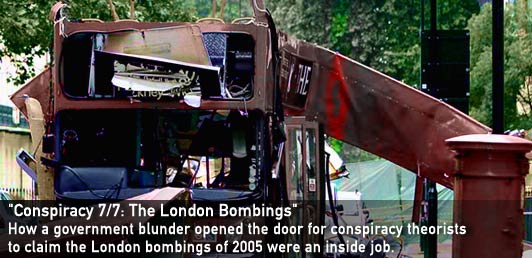
Four Corners' promotion of the BBC 'documentary' presumed that its viewers would unquestioningly
accept their out-of-hand rejection of views which questioned the UK Government's ludicrous account of
the July 7 bombings. The overwhelming repudiation of this program on their viewers'
feedback pagesproved them wrong.
See also: The July 7 Truth Campaign.
ABC 4 Corners peddles UK Government 7/7 Big Lie, censors 9/11 widows
On Monday 31 August as the 8th anniversary of the September 11 terrorist atrocity was fast approaching, ABC's four corners broadcast a BBC documentary "Conspiracy 7/7 - The London Bombings" which purported to "assess the truth behind the conspiracy theories" behind the London Tube Bombings of 7 July 2005. In fact, it did nothing of the sort. It merely attempted to discredit the whole British 7/7 Truth movement by focusing on a few questionable individuals within it. By broadcasting this rubbish and refusing to broadcast other well-researched material which blows apart the Official 7/7 story, as well as the Official 9/11 story, the ABC has shown itself, far from being biased to the left, to be be little better than another arm of global corporate propaganda.
The program, like so much other sham reporting ostensibly criticising Western government 'blunders' over 9/11, Afghanistan, etc. in recent years, the documentary purported to be a fearless indictment the UK government, specifically it promised to tell of "how a government blunder opened the door for conspiracy theorists to claim the London bombings of 2005 were an inside job".
Its real effect was to shore up the UK Government lies over 7/7 used to further its war aims in Iraq and Afghanistan.
The Official story of the London Tube Bombings is in contradiction with the physical evidence of the bombed trains and bus and eyewitness accounts, but the BBC and the UK media failed to demand proper explanations for those inconsistencies. Moreover, there has been no inquiry into 7/7, not even one like the rigged 9/11 Commission. The July 7 Truth Movement has consistently demanded a proper inquiry.
Having spoken to several people who viewed the program, it sounds as though that the program had the intended effect on a large number of viewers of convincing them that 7/7 Truthers, as well as 9/11 Truthers were fruit loops and that the Official accounts of 7/7 and 9/11 were right after all.
However, judging by the comments, even on 4 Corners' heavily censored and edited feedback pages, few properly informed viewers were fooled. Here are some
:
farcical (6 Sep): Another hysterical comedy, albeit for the innocent dead and maimed of course, from the bbc (and yes 'big brother corporation' is exactly right) - seconded by our so-called flagship current affairs program 4Cs...!! pathetic!!
Erik @ Sydney (4 Sep): Peter Powers told us on two seperate media outlets on the day that they
"were actually running an exercise for a company of over a thousand people in London based on simultaneous bombs going off precisely at the railway stations where it happened this morning"
Wow, how fortuitous! And what a co-incidence!
This is the KEY to the false flag operation on that day.
There are two kinds of people in this world. Ones who are awake and ones who are asleep. When you wake up you can start to see the bullshit as it happens. It's not that we are paranoid, it's just that we are alert and immune to the lies.
The ones who sleep, they can't help but not notice anything. They love to eat up every government line and official story that's regurgitated by the Main Stream Media like Four Corners. They also like to proclaim how right they are because the believe the government, that makes them Holy.
Four Corners you should really be ashamed of yourself for posting this BBC hit piece. I am disgusted in you and so are many others.
iracund (regarding 9/11) (3 Sep): In the week before the anniversary of the 9/11 attacks, why would the producer of Four Corners chose to present a B-grade tabloid program, whose very title implies that anyone who doubts any official conspiracy theory is as "loony" as the subject of that program?
As a "loony troofer", who is used to the deafening wall of silence emanating from the ABC and other MSM organs, I'm more than loony enough to present the following facts:
In New York on Sept 11 2001, three first world over-engineered skyscrapers completely collapsed suddenly, swiftly and symmetrically, through their own structure. There is and always has been only one possible explanation for that.
In a hundred+ years of steel frame high-rise construction, the only buildings to collapse in that manner, have all been the result of controlled demolitions.
Both Towers not only imploded through their paths of most resistance, they also exploded, expelling materials upward and outwards over a distance of 4 to 5 hundred feet. The material included virtually all the concrete, which was pulverised to the consistency of talcum powder: huge girders, which were expelled laterally with enough force to impale themselves in neighbouring buildings: and smithereens of human bone, which were found in rubble deposited on the roof of the Deutche Bank building, in April 06.
How is any of this possible from a gravity-only driven collapse?
When challenged by members of the US public on the "fall time" of WTC7, the National Institute of Standards in Technology (NIST) was forced to revise its belated report and admit that this building spent at least 2 seconds in free fall. For any building to achieve free fall, it has to have its supporting structures synchronously cut, through its entire cross section. This is only possible with the assistance of expertly placed explosives.
The recently discovered evidence that a heavily engineered form of military grade, "nano-ized"thermitic material was discovered in the dust from the 9/11 WTC catastrophe merely confirms what was already known: that all three skyscrapers were demolished. Not only is controlled demolition the Occam's Razor for those collapses, it is the only possible explanation.
To quote a fictional character to compliment the fiction of the official story: "Once you've eliminated the impossible, whatever is left, however improbable is the "troof".
NB (3 Sep): WHEN YOU INSULT 9/11 TRUTH YOU INSULT THE VICTIMS' FAMILIES. 9/11 TRUTH IS THE FAMILY MEMBERS! They are the ones pressing for a proper investigation. Their valid questions deserve answers.
Shame on you ABC. Millions of people worldwide have examined the extensive and conclusive EVIDENCE concerning the truth of 9/11. How much longer can you continue your pathetic and desperate cover up?
I laughed out loud at the comment by "grizzlysmit" about not having found 9/11 Truth on the internet. Try putting "9/11 Truth" into Google - over 93 million hits. Can you work Youtube? Start by watching World Trade Centre 7 (47 storeys) fall to the ground in 7 seconds (not hit by a plane) and the comments by Larry Silverstein (who took over the leases of the 3 WTC buildings 6 weeks before 9/11) where he discusses giving the order to "pull" the building. You don't even need to go any further than the ABC website. Go to their "Unleashed" section and search for Hereward Fenton's excellent article. Once you have caught up, check out the peer-reviewed study on the nanothermite (explosive) found in the dust at the Twin Towers.
The number of politicians, eyewitnesses, architects, engineers, physicists, scientists etc standing up for 9/11 Truth is truly staggering. Check out Scholars for 9/11 Truth. You want celebrities? Start with Channel 9's star, Charlie Sheen.
The ABC's role in this shameful cover up is criminal. Those at the very top at the ABC will be held accountable. As for the ABC "journalists" who know the truth, stand up together. You are not only going to have to answer to the general public, but your families and children as well.
9/11 Truth is not going away. It is growing every day as more and more people find out.
Harry Tuttle (2 Sep): Nobody that was charged with terrorism on 7/7 has ever been convicted in a court of law, despite £100m being spent on an investigation. [Read Guardian article.]
However the Big Brother Corporation (BBC) claims they are guilty - so they must be!
In the future could the ABC should show BBC "documentaries" in a fiction time slot (along with Doctor Who etc), so as to not tarnish the Four Corners reputation.
PABULUM (2 Sep): What is interesting in the BBC article is that Binny Netanyahu has recanted of his previous statement that he received a warning to stay in his hotel room prior to the actual bombing. Netanyahu originally stated that the warning came from Scotland Yard, Scotland Yard has denied warning Netanyahu. The next statement from whom, I don't know, was that the warning from Scotland Yard went first to the Israeli Embassy. There was no more about the warnings made public after that statement, that I am aware of.
So now Netanyahu is still stating that he received a warning from Scotland Yard, but only after the first bombs went off. Oh dear!!!!!!!!
Apparently Binny had forgotten, and the journalist had ignored the fact because it had been stated earlier on in this BBC article that the first bombs, that is the bombs that went off on the trains simultaneously were initially reported as being 'power surges'. They were never reported as bombs until after the bus was blown up outside Tavistock House in Russell Square.
What we now have is corroborating statements from Binny that he was personally involved with the London Bombing.
The one major piece of evidence that was totally ignored was the article written by Efraim Halevi that was printed in 'The Jerusalem Post on 7/7/05 in regard to the London Bombing. Halevi's article tells us who the perpetrators were, and that the same people were responsible for 911.
(PABULUM 02 Sep 09): ON 7/7 THE SPOOKS were conducting a similar operation/exercise strangely at the very same location on the very same day.???
Also on 9/11 SPOOKS conducted some 5 military exercises on the very same day of America being attacked.???
Strangely also the yankee military carried out exercise ops.in 1932 and 1938 of Hawaii being attacked by carrier borne aircraft.
History sure repeats itself.
Wake up-- they who lead us lead us astray.
(PABULUM 02 Sep 09): FOUR CORNERS at the top says, "Investigative TV journalism at it's best." ? ...
May I issue a challenge forthwith to all these intrepid men and women to reveal the absolute truth about this claim.
Prove to me categorically that WTC 7 NYC 9/11 WAS NOT IMPLODED.
Go to it folks your time starts from now.
911oz (02 Sep): Subject Welcome to the War on Reason!
This message is directed not at the ABC editors who I believe are beyond help, but at those thoughtful readers who have posted here or who may be browsing this page.
We are faced with an epic struggle of science and reason Vs dogma and mass hysteria. This kind of struggle is not new in human history. The fight must be won again, as it was won in past ages.
And we WILL win folks.
[edited]
Hereward Fenton
wezthebikie (2 Sep): As an Australian taxpayer, I am quite concerned that the ABC, has now attached itself to the bottom of the barrel, along with the Commercial Television Stations. I would hope that after that disgraceful farce, that 4 Corners has described as, 'Investigative Journalism', the Government will now concede, that we should no longer have to pay for the running of the ABC. Please feel free to reimburse my taxes, that have been spent, running the ABC. I am also convinced that, A Current Affair and Today-Tonight, will be happy to have company at the bottom of the barrel, where ABC 'Journalism', has now placed itself. P.S. How about a new 'Investigative Journalism' effort, into the Nano-Thermite, that has been found in the dust of the World Trade Centre Buildings. Let's see if you can make as big a disgrace of yourselves, as what your 7/7 'Investigative Journalism, did.
bbc hit piece (2 Sep): I've noticed almost everyone who has commented on the BBC 7/7 program has been appalled not only by the journalism but by the obvious debunking of the conspiracy theory that British intelligence and the British Gov were behind the tube station bombings. What better way to debunk the conspiracy theorists than to pick a couple of crazies out of several million sane and intelligent "truthers" and let them dig their own graves. Is it possible the demolition van was planted at Tavistock Square [address of British MK Ultra mind control think tank!] to later debunk those who were not thorough enough on their research? To suggest governments have not or do not carry out terror on their own populations is to show a complete lack of historical knowledge. Please read up on Operation Northwoods and make up your own mind. Also, anyone who believes the official 9/11 tale is an idiot.....plain and simple.
iracund (02 Sep): It's a sad day for Australian TV journalism when the ABC's flagship, Four Corners is forced to run the trash like the "Conspiracy Files", a term which is bandied about to divert public attention away from asking legitimate questions about 9/11, 7/7, Bali et al.
At least the BBC's Third Tower, gave a voice to Professor Steven Jones and Richard Gage, two of the leading lights of the 9/11 Truth Movement, for the first time on Oz TV. This one seems to have simply picked on one (possibly mentally ill) person in order to taint anyone with legitimate questions or feasible alternative theories to the official ones.
In the case of 9/11 for example, (the Crime of the Century) there has been no investigation by Four Corners on the actual events and evidence of that day. Or the many serious questions remain ignored, unanswered or inadequately answered by the official conspiracy theories.
Could it be that the once great Four Corners have programed this twaddle a week before the anniversary of 9/11 to reinforce the official view that all so called "conspiracy theorists" are all loonies? Especially this year, when the producer of that program knows that highly qualified scientist have a published, vigorously peer-reviewed, and unchallenged paper, which provides conclusive evidence that all three buildings in NY on that day were demolished by cutting edge, military grade explosives. (Cf: Active Thermitic Material Discovered in Dust from the 9/11 WTC Catastrophe).
Dare I suggest that your failure to report on this and many other suspicious events on that day, puts you in breach of your charter.
9/11 Truther Kim Bax attempted to post comments but said they seemed censored or were heavily edited (see Appendix 1 below). This led to phone calls and exchanges (mostly one-way) of e-mails between her and 4 Corners staff. In her e-mails, she asked why after all these years, no-one on the ABC had interviewed the "Jersey Girls". The "Jersey Girls" are widows who lost their husbands on that day and forced the Bush administration to finally hold an Inquiry into 9/11, as rigged that it turned out to be. Details of Kim Bax's correspondence can be found at www.kimspages.org/abc4corners.htm
Even Phillip Adams, an ostensible left-winger and opponent of US Foreign Policy, who on one occasion praised the "Jersey Girls" refuses to interview them and maintains that all the 9/11 Truth Movement (presumably including the "Jersey Girls") are "nutters". For the correspondences between Kim Bax and Phillip Adams, please go to www.kimspages.org/phillipadams.htm.
Appendix 1: Edited comment by 7/7 and 9/11 Truther Kim Bax
I am at a loss to understand why my comments (posted below), were so heavily edited, and I have emailed 4 Corners privately, asking for a written explanation (they have my full contact details). The information that was cut were links, freely available to anyone on the net who cares to use a google search engine , to check the truth of the facts in my "Letter to the Editor."
Further, I am also at a loss to understand why there is no response from ABC 4 Corners (on this message board), to the two very legitimate questions I have posed in that post...
The core of the matter seems to be that the British Government has (to this day), strenuously resisted all calls for a public inquiry into 7/7, and that the 9/11 Commission was only formed after a 14-month fight by bereaved family members - further still, these same family members (who ABC 4 Corners seems to have consistently ignored), are grossly dissatisfied with the 9/11 Commission, and they have been calling for a new judicial review since 2004. What Planet does ABC 4 Corners live on for that not to be "News"?
Again, I very much hope this entirely legitimate post of mine is allowed on the ABC message board. I'll certainly be posting it on my own blog, and circulating the info.
wiccedwoman (02 Sep):
Subject An open question to 4 Corners
Yesterday, I circulated this 136-word "Letter to the Editor" to 100's of local papers all over Australia (I collated the email addresses ages ago, when I was involved in other community campaigns):
"As another anniversary of 9/11 comes round, the World should pay its respects to the widows and mothers of that day by a single voice demanding truth and justice. Without Kristen Breitweiser, Patty Casazza, Lorie Van Auken, and Mindy Kleinberg, nicknamed "The Jersey Girls," The 9/11 Commission would not have existed. They fought Bush for 14 months, before he caved to an inquiry. Even so, it cost over three times less than the investigation into Clinton’s sex life and finances, over 70% of the women’s questions remain ignored, and to this day, they are still fighting for an independent judicial review. Bizarrely, even "Respected" Australian journalists like Phillip Adams refuse to interview them. For a deeper look at this issue, I strongly recommend "9/11 Press for Truth," which was screened by The History Channel in 2007."
. . . and as a result, my questions to 4 Corners are, (as we approach the 8th anniversary of 9/11), wouldn't it have been more appropriate to interview "The Jersey Girls" in depth about their continuing campaign for a new judicial review of 9/11, rather than screen this BBC piece (of doubtful quality in my opinion)? And secondly, has the ABC ever interviewed "The Jersey Girls" about their continuing campaign?
Further, here are the links I also sent out with that short letter to back up the points I make (and especially as regards the point I make about Phillip Adams, you are more than welcome to speak with him directly about the veracity of my correspondence with him). Lastly (before I publish those mentioned links), I'll also be posting this comment yourselves on numerous Australian email lists (and to my various other contacts), with a comment as to whether or not you allowed to be published on your board. I very much hope it is, and I very much hope I get some direct answers to these very reasonable questions.
Appedix 2: Comments in support of BBC 'documentary'
pixie 4 Sep): It's really great to hear what the conspiracy/no moon landings crowd think !
I hope 4Corners runs the same show next year.
Pythinia (3 Sep): Amazing what a little technology jargon will do for a conspirator theorist - what hate has been spilt on the pages by posters on the Four Corners airing of the 7th July 2005 bombing, plus dragging in other tragedies to up the anti.
We are unconvinced - try again.....




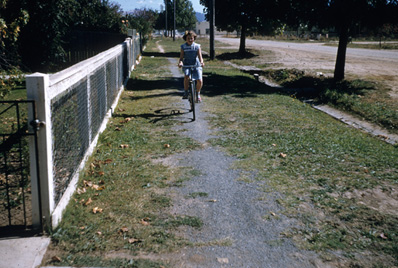




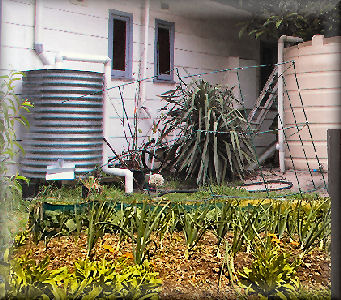
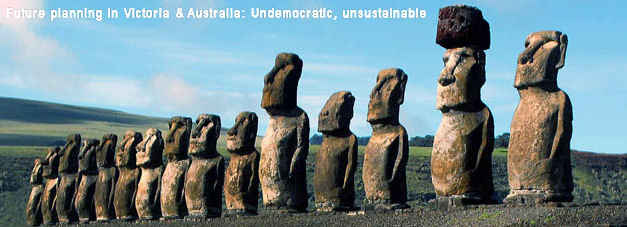

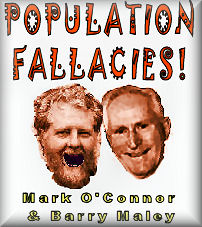











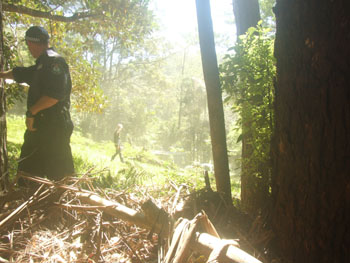
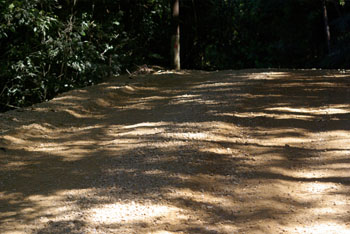

 Picture: area to be developed for heavy industry
Picture: area to be developed for heavy industry

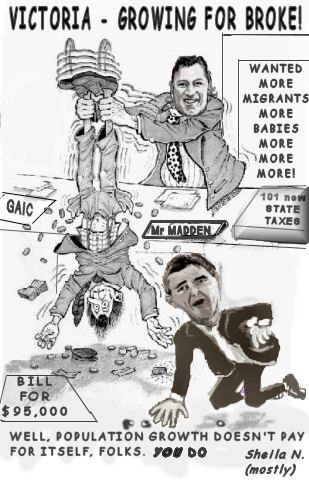 (Parts of cartoon based on one signed "V.D." which is all over the net, but no attributions available.)
(Parts of cartoon based on one signed "V.D." which is all over the net, but no attributions available.)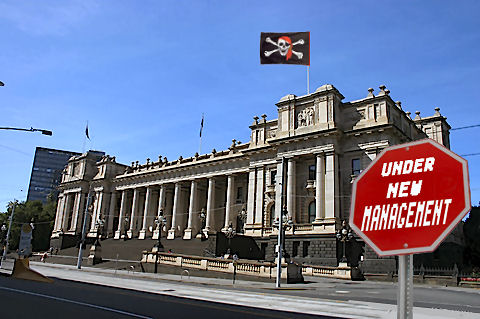



 These are dark times for Australia and Victoria is one of the darkest places in the country for democracy. There are, however still some good people in parliament and we must support their efforts. The Greens and the Opposition need the electorate's help to have this bill stopped in the upper house. They have done it before, so they can do it again.
These are dark times for Australia and Victoria is one of the darkest places in the country for democracy. There are, however still some good people in parliament and we must support their efforts. The Greens and the Opposition need the electorate's help to have this bill stopped in the upper house. They have done it before, so they can do it again. 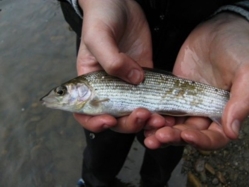 (Grayling; Photo from Wikipedia commons)
(Grayling; Photo from Wikipedia commons) Through incompetence and neglect 110 ha which was recently added to the Pines Flora and Fauna reserve was mismanaged by Parks Victoria and Department of Sustainability Victoria to the point where nearly all the species it contained have become extinct. Now this land is due to be separated by a huge tollway from the rest of the reserve, despite many bitter protests and submissions from residents and other concerned people, whose hearts are nearly broken. See also
Through incompetence and neglect 110 ha which was recently added to the Pines Flora and Fauna reserve was mismanaged by Parks Victoria and Department of Sustainability Victoria to the point where nearly all the species it contained have become extinct. Now this land is due to be separated by a huge tollway from the rest of the reserve, despite many bitter protests and submissions from residents and other concerned people, whose hearts are nearly broken. See also 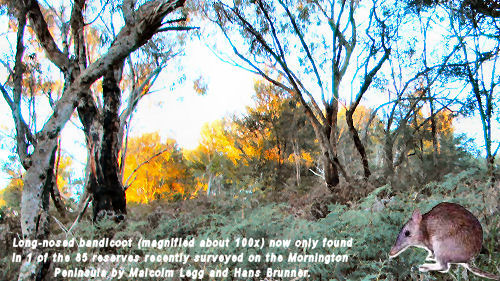
Recent comments